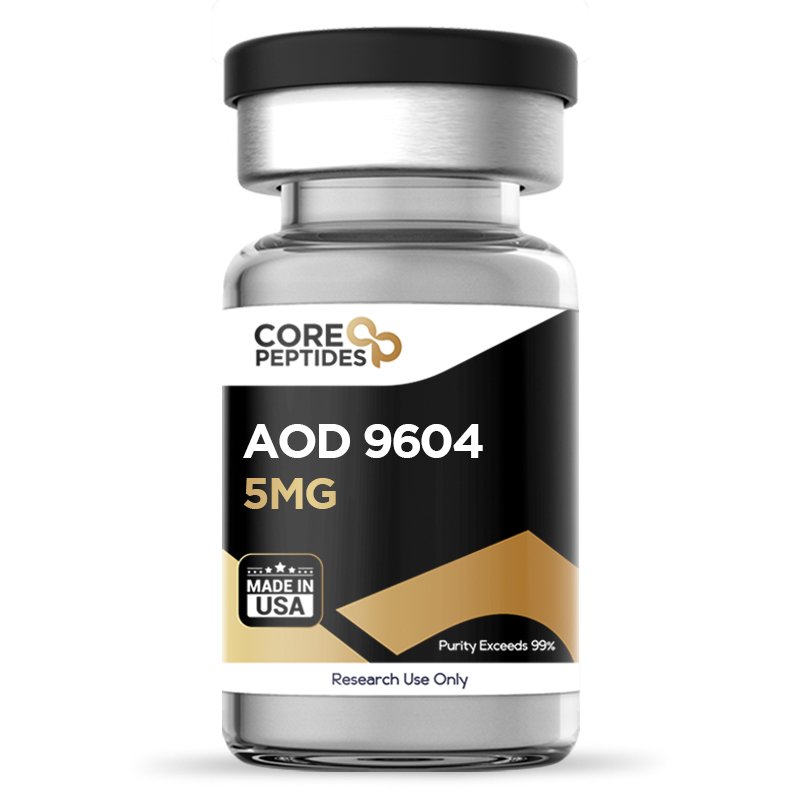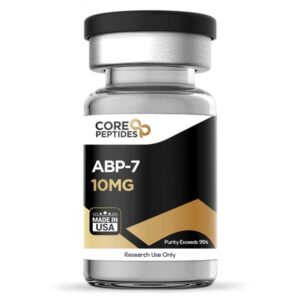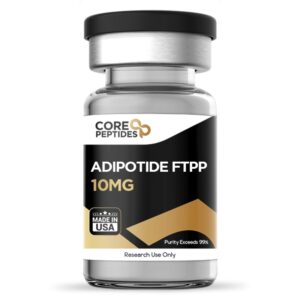Description
AOD 9604 Peptide
Description
AOD 9604 is a synthetic analog of human growth hormone (hGH) that has been specifically engineered for the study of lipolytic and anti-obesity mechanisms. Derived from the C-terminal fragment (amino acids 176–191) of the full-length hGH molecule, AOD 9604 retains the region responsible for fat metabolism without activating the mitogenic and insulin-stimulating properties typically associated with native growth hormone.
The peptide features a tyrosine residue substitution at the N-terminus, which is believed to enhance molecular stability and biological activity. Researchers often refer to AOD 9604 as the “lipolytic fragment of hGH” due to its selective capacity to stimulate fat breakdown (lipolysis) while potentially avoiding the anabolic or diabetogenic effects of full-length GH.
AOD 9604 has attracted significant research interest for its metabolic and regenerative potential, particularly in models of obesity, cartilage degeneration, and tissue repair. It is also under investigation for its potential adjuvant role in targeted drug delivery systems, including anticancer applications.
Mechanism of Action
AOD 9604 is thought to act by stimulating lipolysis (the breakdown of fat) and inhibiting lipogenesis (the formation of fat) through multiple metabolic pathways:
-
Beta-Adrenergic Receptor Modulation:
Research suggests that AOD 9604 may upregulate beta-3 adrenergic receptor (β3-AR) expression in adipocytes (fat cells), enhancing their sensitivity to natural lipolytic stimuli such as catecholamines. -
Enhanced Fat Oxidation:
Experimental data indicate that the peptide may increase energy expenditure and fatty acid oxidation, promoting the mobilization and utilization of stored fat as an energy source. -
Non-IGF Pathway Action:
Unlike hGH, AOD 9604 does not appear to stimulate insulin-like growth factor 1 (IGF-1) production. This distinction is crucial, as IGF-1 is associated with cell proliferation and potential carcinogenic activity. Thus, AOD 9604 may exert its lipolytic effects without influencing growth-promoting or insulin-potentiating pathways. -
Potential Beta-Adrenergic Independence:
While β3-AR expression may play a role in chronic fat metabolism, studies in receptor knockout mice suggest that AOD 9604’s lipolytic effects may also operate through alternative signaling pathways, including AMP-activated protein kinase (AMPK) activation and mitochondrial oxidation enhancement.
Chemical Makeup
-
Molecular Formula: C₇₈H₁₂₃N₂₃O₂₃S₂
-
Molecular Weight: 1815.12 g/mol
-
Other Names: hGH Fragment 176–191, Tyr-hGH Fragment 177–191
-
Form: Lyophilized powder
-
Purity: >99% (HPLC verified)
-
Storage: Store at −20°C; protect from light and moisture
Research and Clinical Studies
1. AOD 9604 and Lipolytic Activity
In early experiments involving obese mice, AOD 9604 administration for 14 days resulted in significant weight reduction and fat loss compared to controls. These effects correlated with elevated expression of β3-adrenergic receptors in adipose tissue.
Further studies using β3-AR knockout mice suggested that AOD 9604 may induce fat loss through increased energy expenditure and enhanced fat oxidation, indicating multifactorial metabolic mechanisms beyond simple receptor stimulation.
(Heffernan et al., 2001)
2. AOD 9604 and Obesity Models
In a pivotal study conducted on Zucker obese rats, daily AOD 9604 exposure for 19 days resulted in a >50% weight reduction compared to placebo-treated controls. The treatment also improved lipid metabolism without altering insulin sensitivity, distinguishing it from native growth hormone exposure, which can induce insulin resistance.
(Ng et al., 2000)
A 2004 human clinical trial involving 300 obese participants reported consistent weight loss and modest improvements in cholesterol and glucose tolerance following AOD 9604 administration over 12 weeks.
(News-Medical, 2004)
3. AOD 9604 and Cartilage Regeneration
A 2015 rabbit study investigated AOD 9604 alone and in combination with hyaluronic acid (HA) for cartilage repair. Rabbits treated with the combination exhibited the least cartilage degeneration, suggesting synergistic chondroprotective and regenerative effects.
Histological evaluation indicated enhanced chondrocyte proliferation, proteoglycan synthesis, and collagen formation, all of which are key to cartilage health and joint integrity.
(Kwon & Park, 2015)
4. AOD 9604 and Tissue Differentiation
In vitro research suggests that AOD 9604 may promote the differentiation of mesenchymal stem cells (MSCs) into osteogenic (bone-forming) cells. Additionally, studies on C2C12 myoblasts have indicated enhanced muscle cell maturation, implying potential tissue repair and regenerative applications.
5. AOD 9604 in Cancer Research
Recent investigations have examined AOD 9604’s role as a targeting ligand in nanocarrier-based drug delivery systems. When conjugated to chitosan nanoparticles loaded with doxorubicin, AOD 9604 significantly enhanced anticancer efficacy against MCF-7 breast cancer cells, increasing tumor cell uptake and cytotoxic activity while minimizing off-target effects.
(Habibullah et al., 2022)
Certificate of Analysis (COA)
| Test | Specification | Result |
|---|---|---|
| Appearance | White lyophilized powder | Conforms |
| Purity (HPLC) | ≥99% | 99.3% |
| Mass Spectrometry | Consistent with theoretical MW | Pass |
| Solubility | Soluble in water | Pass |
| Identity | Verified by peptide sequencing | Confirmed |
HPLC and Mass Spectrometry
HPLC Analysis:
High-Performance Liquid Chromatography confirms >99% purity, ensuring high analytical accuracy and batch-to-batch consistency.
Mass Spectrometry:
MS analysis validates the molecular identity and structural fidelity of AOD 9604, confirming a molecular mass of approximately 1815.12 Da.
Potential Research Implications
-
Obesity and metabolic syndrome models
-
Lipid metabolism and fat oxidation studies
-
Musculoskeletal regeneration (bone, cartilage, and muscle repair)
-
Cancer nanotherapy and drug delivery research
-
Growth hormone receptor-independent metabolic modulation
References
-
Heffernan M, Summers RJ, Thorburn A, et al. Endocrinology. 2001;142(12):5182–5189. [PMID: 11713213]
-
Moré MI, Kenley D. J Endocrinol Metab. 2014;4(3):64–77.
-
Ng FM, Sun J, et al. Hormone Research. 2000.
-
News-Medical Life Sciences. “Obesity drug codenamed AOD 9604 highly successful in trials.” December 16, 2004.
-
Kwon DR, Park GY. Ann Clin Lab Sci. 2015;45(4):343–349.
-
Habibullah MM et al. Drug Des Devel Ther. 2022;16:1963–1974. [DOI: 10.2147/DDDT.S367586]
-
Dr. Marinov, MD, Ph.D. Preventative Medicine & Public Health, University of Sofia.
Disclaimer
AOD 9604 Peptide is supplied for research and laboratory use only. It is not intended for human consumption, therapeutic, or diagnostic applications. All handling and use should comply with institutional and regulatory research guidelines.





Reviews
There are no reviews yet.